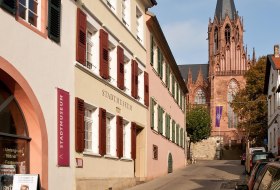
searchMenu


The Rheinhessisch Postmuseum presents an outline of the regional postal history with a focus on letter post in rural areas. Postmarks, mailboxes and post signs from over 150 years are exhibited here. Groups are very welcome. Guided tours are also possible. Admission is free.

The Oppenheim Town Museum offers a tour through the rich and eventful history of the town - from prehistory to the end of the Second World War. It is the perfect complement to a visit with or without a tour guide. The first floor displays finds and historical information from Roman times to the 17th century. Further information: www.oppenheimer-geschichtsverein.de Admission is free!


The trullo, the trulli - the special little vineyard house in Rheinhessen. Former shelters in the vineyards for the workers, but also intended for the "Wingertsschütz" who guarded the vineyards.

Every Roman city, even small ones, had theatres and baths. Historians therefore always assumed that a theatre or amphitheatre also existed at some stage in Mogontiacum. However, the discoveries made between 1914 and 1916 when a new road to the citadel was being constructed, took everybody by surprise. Excavations revealed a Roman theatre of gigantic size, the largest such building north of the Alps with an auditorium of 116 metres in width. Its stage alone measured 42 metres. The theatre was large enough for around ten thousand people, which…

The cross vault in the Korfmann Winery, built in 1840, was turned into a wine tavern in 1999, which can accommodate up to 50 people. General information on Rheinhessen cow chapels .The origin of the typical Rheinhessen vaults goes back to the early 19th century. At that time, farmers wanted to increase the yield of their cattle by keeping them in stables and use the leftovers as fertiliser for their fields. Initially, the cattle were housed on the ground floor of the half-timbered houses, above which hay and straw were stored. However,…

After St. Martin's, the only place of worship until then, had been awarded to the Reformed during the division of the church, the Catholics initially had to move to a chapel in honour of all the saints at Bornstraße 14. The Catholic cemetery had been located there since 1610. The Catholic Church of Our Lady of Sorrows was built in 1733. Its construction was made possible by a donation from the Mainz patrician family Gedult von Jungenfeld, who provided the land. The interior is partly furnished with furniture from other Christian…

Katholische Kirche "Christkönig" Köngernheim